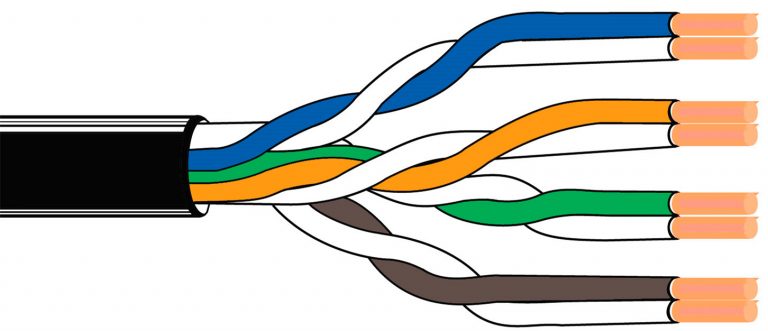Twisted Pair Cabling Overview
Nowadays, fiber optic cable becomes one of the most popular mediums for both new cabling installations and upgrades, including backbone, horizontal, and even desktop applications. Though fiber offers a number of advantages over copper, copper still has a space in telecommunication networks, for example, direct attach copper cables, like HP JG081C 10G SFP+ direct attach copper cable or Cisco QSFP+ breakout cable (Cisco QSFP-4SFP10G-CU5M). As one of the oldest types of cable ever invented, twisted pair cable was first developed in 1881. Since then, it has been widely deployed for telephone line networks. Nowadays, the application of twisted pair cables has been extended worldwide mainly for outdoor land lines offering telephone voice service.
Twisted pair cable is a kind of copper wiring made by putting two separate insulated wires together in a twisted pattern and running them parallel to each other. It is widely used in different kinds of data and voice infrastructures. To reduce crosstalk or electromagnetic induction between pairs of wires, two insulated copper wires are twisted around each other. Each connection on twisted pair requires both wires. Twisted pair can offset electromagnetic interference (EMI) from external sources to stop degrading the performance of circuit.

There are two twisted pair types: shielded and unshielded. A shielded twisted pair (STP) has a fine wire mesh surrounding the wires to protect the transmission; an unshielded twisted pair (UTP) does not. Shielded cable is used in older telephone networks, as well as network and data communications to reduce outside interference.
Also, different standards of twisted pair cables are specified into various categories as Cat 1, Cat 2, Cat 3, Cat 4, Cat 5/5e, Cat 6/6a, Cat 7/7a, Cat 8/8.1/8.2. And the following text will briefly introduce several categories.
Cat 5 twisted pair cable is often used for structured cabling of computer networks. It is available to 10/100 Mbps speeds at up to 100 MHz bandwidth. However, it is now considered to be obsolete and replaced by Cat 5e (enhanced). Cat 5e is one the most commonly used twisted pair cables now. The biggest distinction between Cat 5 and Cat 5e is that Cat 5e has a lower crosstalk and its transmitting speed can reach up to 1000 Mbps.
As a substitute of Cat 5/5e, Cat 6 twisted pair cable is applied to Gigabit Ethernet and other network physical layers. Cat 6 supports up to 10 Gbps speed at 250 MHz. When used for 10GBASE-T applications, Cat 6 has a reduced maximum length from 37 to 55 meters. Cat 6a (augmented) twisted pair cable has been evolved to perform at up to 500 MHz, thus the maximum cable distance is longer than Cat 6 of up to 100 meters.
Cat 7 is the standard for twisted pair cabling used for 1000BASE-T and 10GBASE-T networks. It provides performance of up to 600 MHz with a maximum length of 100 meters. Cat 7a (augmented) twisted pair cable has a higher frequency of 1000 MHz. Results show that Cat 7a may be possible to support 40 GbE or even 100 GbE at a very short length.
Cat 8 is the USA standard specified by ANSI/TIA while Cat 8.1 and Cat 8.2 are specified by ISO/IEC for global application. All these three kinds of Cat 8 twisted pair cables are used for 25GBASE-T and 40GBSE-T at the maximum frequency of up to 2 GHz. Except Cat 8 adopts Cat 8 links, Cat 8.1 uses class I links and Cat 8.2 uses class II links. The key difference between class I and class II is that class II allows three different styles of connectors that are not compatible with one another, or with the RJ45 connector.
Twisted pair cables have been classified into different grades called categories. Higher categories are more expensive than lower ones, but most of the cost is actually spent on labor force for installing the cables. And twisted pair cables under Cat 5 are not recommended now. Higher categories are the future trends for network cabling.

